340th Flying Training Group
The 340th Flying Training Group (340 FTG) is an Air Reserve Component (ARC) of the United States Air Force. It is assigned to the Tenth Air Force, Air Force Reserve Command, stationed at Randolph Field, Joint Base San Antonio, Texas.
| 340th Flying Training Group | |
|---|---|
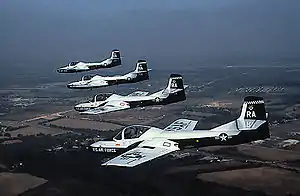 T-37s of the 340th Flying Training Group | |
| Active | 20 August 1942 – present |
| Country | |
| Branch | |
| Type | Group |
| Role | Flying Training |
| Part of | |
| Garrison/HQ | Randolph Field, Joint Base San Antonio, Texas |
| Tail Code | "RA" |
| Insignia | |
| 340th Flying Training Group emblem | 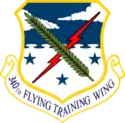 |
| Aircraft flown | |
| Trainer | T-1 Jayhawk T-6 Texan II T-38 Talon |
The 340th FTG is an associate unit of the 12th Flying Training Wing, Air Education and Training Command (AETC).
Overview
The 340 FTG administers and executes the Air Education and Training Command (AETC) and Air Force Reserve Command (AFRC) Associate Instructor Pilot Program and provides Active Guard Reserve and Traditional Reserve IPs to augment the cadre of active duty pilots conducting pilot training.
The group has inherited the history and traditions of the Second World War 340th Bombardment Group. The 340th BG flew B-25 Mitchell medium bombers at part of Twelfth Air Force, engaging chiefly in support and interdiction missions. The 340th participated in the reduction of Pantelleria and Lampedusa in June 1943, the bombing of German evacuation beaches near Messina in July, the establishment of the Salerno beachhead in September, the drive for Rome during January to June 1944, the invasion of Southern France in August, and attacks on the Brenner Pass and other German lines of communication in Northern Italy from September 1944 to April 1945. Active for over 60 years, the 340th Bombardment Wing was a component organization of Strategic Air Command's deterrent force during the Cold War, as a strategic bombardment wing.
Units
The Group consists of a headquarters element at Randolph AFB and five Associate Reserve Flying Training Squadrons flying the T-38/AT-38, T-1, and T-6.
- 5th Flying Training Squadron at Vance AFB, Oklahoma
- 39th Flying Training Squadron at Randolph
- 43d Flying Training Squadron at Columbus AFB, Mississippi
- 96th Flying Training Squadron at Laughlin AFB, Texas
- 97th Flying Training Squadron at Sheppard AFB, Texas
- 433d Training Squadron at Lackland AFB, Texas
History
World War II

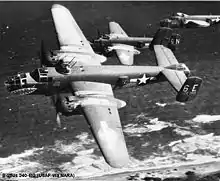
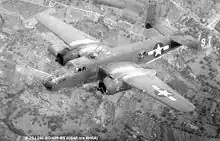
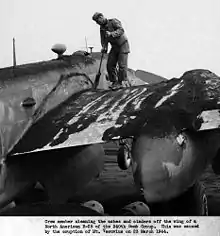
The 340th Bombardment Group was a World War II United States Army Air Forces combat organization. It served primarily in the Mediterranean, African, and The Middle East Theatres of World War II. From August 1942 to November 1945 it controlled 4 operational squadrons: the 486th, 487th, 488th, & 489th Bombardment Squadrons utilizing the North American B-25 Mitchell medium bomber.
Operational squadrons of the 340th Bomb Group utilized identification codes applied to the outboard sides of the vertical fins featuring a squadron-designated numeral, coupled with a letter for the individual aircraft: the 486th(6x), 487th(7x), 488th(8x), and 489th(9x) Bombardment Squadrons.
The unit was constituted as 340th Bombardment Group (Medium) on 10 August 1942 and was activated on 20 August. Trained with B-25 Mitchell bombers for duty overseas. Arrived in the Mediterranean theater in March 1943. Assigned first to the Ninth Air Force IX Bomber Command and later (in August 1943) to the Twelfth Air Force when the Ninth was reassigned to England.
The 340th served in combat from April 1943 to April 1945. Engaged chiefly in support and interdictory missions, but sometimes bombed strategic objectives. Targets included airfields, railroads, bridges, road junctions, supply depots, gun emplacements, troop concentrations, marshalling yards, and factories in Tunisia, Sicily, Italy, France, Austria, Bulgaria, Albania, Yugoslavia, and Greece.
Also dropped propaganda leaflets behind enemy lines. Participated in the reduction of Pantelleria and Lampedusa in June 1943, the bombing of German evacuation beaches near Messina in July, the establishment of the Salerno beachhead in September, the drive for Rome during January–June 1944, the invasion of Southern France in August, and attacks on the Brenner Pass and other German lines of communication in northern Italy from September 1944 to April 1945.
In January 1944, Colonel Charles D. Jones was the commanding officer of the 340th Bombardment Group. On 10 March 1944, while participating in a bombing mission with the 486th Bombardment Squadron, he was shot down and became a prisoner of war (POW) for the remainder of the war. Colonel Jones later received the Distinguished Flying Cross (DFC) for this mission.[1]
The 340th Bombardment Group probably suffered the loss of more aircraft than any other medium bombardment group during World War II primarily because of two devastating events that occurred in addition to their normal combat losses. The first of these events was the eruption of Mount Vesuvius in March 1944 when the 340th just happened to be based at Pompeii Airfield near Terzigno, Italy, just a few kilometers from the base of the mountain. The second event was a surprise German air raid of their base at Alesani, Corsica on 13 May 1944. Estimated losses were 75–88 B-25 Mitchells from Vesuvius and approximately 60 aircraft from the German air raid.[1]
The 340th Received a Distinguished Unit Citation (DUC) for the period April–August 1943 when, although handicapped by difficult living conditions and unfavorable weather, the group supported the British Eighth Army in Tunisia and Allied forces in Sicily. A second DUC was received for the destruction of the Italian light cruiser Taranto in the heavily defended harbor of La Spezia on 23 September 1944 before the ship could be used by the enemy to block the harbor's entrance.
With the end of the war in Europe, the 340th returned to the United States during July–August 1945. It was inactivated on 7 November 1945 at Columbia, South Carolina.
The unit was reactivated and continued performing medium bombardment training in the Air Force Reserve from October 1947 to August 1949 at Tulsa Municipal Airport, Oklahoma with B-29 Superfortresses.
B-47 Stratojet era

The United States Air Force Strategic Air Command established the 340th Bombardment Wing, (Medium) on 3 October 1952. It was activated on 20 October 1952 at Sedalia (later Whiteman) AFB, Missouri. The 320th Bombardment Group was its operational component, with the 441st, 442d and 443d Bomb Squadrons. The 320th was assigned to Second Air Force.
The 340th replaced and absorbed the resources of the 4224th Air Base Squadron in October 1952. Whiteman at the time was undergoing a massive modernization program, from its World War II configuration of temporary buildings and short runways designed for glider and pilot training to that of a modern, permanent Air Force Base. The wing devoted its efforts to supervising base rehabilitation and new construction until May 1954, This was done by the 340th Air Base Group. The wing headquarters, tactical and maintenance squadrons had minimum manning during this period and were basically "paper" units.
The Wing received its first Boeing B-47E Stratojet in March 1954 and on 1 July 1955, was declared combat ready. The wing also supported the 340th Air Refueling Squadron with KC-97L Stratotankers. On 3 December 1955, Sedalia AFB became Whiteman AFB.
The 340th BMW achieved recognition as one of SAC's first units to reorganize under the Deputy Commander concept of command and control. It tested the feasibility of assigning Aviation Depot Squadron functions to the Deputy Commander for Maintenance. SAC later adopted the plan and accomplished a command-wide change which included the formation of Munitions Maintenance Squadrons. Until 1960, the 340th BMW played a key role in SAC's mission of strategic deterrence. 1961 to 1963 the 34th Air Refueling Squadron (Offutt AFB) was assigned to the 340th BW and operated the "Looking Glass" SAC Airborne Command Post with KC-135's.
By 1962 the B-47 was being programmed for retirement as it was believed that it could not penetrate the air defenses of the Soviet Union. The wing began phasing down and sent its aircraft to other SAC wings or to flyable storage at Davis–Monthan AFB. The 340th inactivated on 1 September 1963 at Whiteman, the host responsibilities for the base being assumed by the incoming 351st Strategic Missile Wing. On 1 September 1963 the 340th BW moved without personnel or equipment to Bergstrom AFB, Texas as the 340th Bombardment Wing, Heavy to replace the 4130th Strategic Wing.
B-52 Stratofortress era

4130th Strategic Wing
On 1 October 1958 Strategic Air Command (SAC) established the 4130th Strategic Wing at Bergstrom as part of SAC's plan to disperse its Boeing B-52 Stratofortress heavy bombers over a larger number of bases, thus making it more difficult for the Soviet Union to knock out the entire fleet with a surprise first strike[2] and assigned it to the 19th Air Division.[3] The wing also assumed USAF host base responsibilities as Bergstrom transferred from Tactical Air Command (TAC) to SAC.[4] Two weeks later the 910th Air Refueling Squadron, flying Boeing KC-135 Stratotankers was activated and assigned to the wing.[4] The wing became fully operational in January 1959 when the 335th Bombardment Squadron (BS), consisting of 15 Boeing B-52 Stratofortresses moved to Bergstrom from Biggs AFB, Texas where it had been one of the three squadrons of the 97th Bombardment Wing[5] and the 50th Aviation Depot Squadron was activated[4] to oversee the wing's special weapons. Starting in 1960, one third of the wing's aircraft were maintained on fifteen-minute alert, fully fueled, armed and ready for combat to reduce vulnerability to a Soviet missile strike. This was increased to half the wing's aircraft in 1962.[6] The 4130th (and later the 340th) continued to maintain an alert commitment until the wing inactivated in 1966. In 1962, the wing's bombers began to be equipped with the GAM-77 Hound Dog and the GAM-72 Quail air-launched cruise missiles, The 4130th Airborne Missile Maintenance Squadron was activated in November to maintain these missiles. On 1 July 1963 the wing was reassigned to the 4th Air Division.[7]
However, SAC Strategic Wings could not carry a permanent history or lineage and SAC looked for a way to make its Strategic Wings permanent.[8] In 1962, in order to perpetuate the lineage of bombardment units with illustrious World War II records, Headquarters SAC received authority from Headquarters USAF to discontinue its Major Command controlled (MAJCON) strategic wings that were equipped with combat aircraft and to activate USAF controlled (AFCON) units, most of which were inactive at the time which could carry a lineage and history.
340th Bombardment Wing
The 340th was reassigned to Bergstrom without personnel or equipment in September 1963, where it assumed the aircraft, personnel and equipment of the discontinued 4130th SW.[9][10] The 486th Bombardment Squadron, one of the unit's World War II historical bomb squadrons, replaced the 335th BS.[11] The 859th Medical Group, 50th Munitions Maintenance Squadron and the 910th Air Refueling Squadron were reassigned to the 340th. The 4130th's support group and maintenance and security squadrons were replaced by ones with the 340th numerical designation of the wing. Each of the new units assumed the personnel, equipment, and mission of its predecessor.
The wing continued SAC global strategic bombardment training and air refueling operations.[9] Beginning in 1965, the Air Force decided to convert most of its B-52Ds to conventional warfare capability for service in Southeast Asia. Foremost among the changes needed was to give the B-52D the ability to carry a significantly larger load of conventional bombs. This led to the Big Belly project which was begun in December 1965.
By 1966, Intercontinental ballistic missiles (ICBM) had been deployed and become operational as part of the United States' strategic triad, and the need for B-52s had been reduced. In addition, funds were also needed to cover the costs of combat operations in Indochina. The 340th Bombardment Wing was inactivated on 2 October 1966 and its aircraft were reassigned to other SAC units.[9]
In connection with the wing's inactivation, Bergstrom AFB was returned to TAC, which closed James Connally AFB in Waco, Texas and moved the headquarters of Twelfth Air Force to Bergsrom and activated the 75th Tactical Reconnaissance Wing as the new host organization at the base.[4]
FB-111A era
After a near two-year inactivation, the unit was reactivated again by SAC as the 340th Bombardment Group, Medium on 2 July 1968 at Carswell Air Force Base, Texas. Although it was given the designation of a bomb group, the 340th was organized and functioned as a SAC Wing. Its operational squadron was the 4007th Combat Crew Training Squadron.
The 340th was given the primary mission of conducting initial qualification training for General Dynamics FB-111A aircrew members. The FB-111A was the all-weather strategic bombing version of the F-111, intended as an interim successor to the B-52 Stratofortress and B-58 Hustler of the Strategic Air Command. The 340th was stationed at Carswell, as the FB-111A were being produced at the huge General Dynamics plant, also known as Air Force Plant #4 in Fort Worth, and it shared the main runway at Carswell.
The first production FB-111A aircraft (67-0159) flew on 13 July 1968. It was accepted by the Air Force on 30 August. A second FB-111A was delivered on 25 October. However, these two planes were powered by TF30-P-12A engines designed for Naval service instead of the Air Force P-7 turbofan. In addition, problems with the avionics subsystem slowed further deliveries, with the Air Force not accepting its next FB-111A until 23 June 1969.
On 8 October 1969 the 7th FB-111A manufactured (67–7193) entered service with the 4007th Combat Crew Training Squadron of the 340th Bomb Group. The 340th's staff and instructor received training in TAC F-111As at Nellis AFB, Nevada with the 4527th CCTS. The Group also maintained a combat crew force capable of conducting bombardment operations if necessary with the FB-111A.
On 7 October 1970, the 340th BMG's first major aircraft accident occurred when FB-111A 68-0253 crashed at Carswell AFB, causing the deaths of Lt. Col Robert S. Montgomery (9th BMS's Commander) and his navigator, Lt. Col Charles G. Robinson.
The 340th BG participated in SAC's annual Bombing and Navigation Competition held at McCoy AFB, Florida from 13–20 November 1970. Showing an outstanding performance, the group finished the competition first in bombing and second in navigation. The 340th also participated in the Strike Command Bombing and Navigation held 17–23 April 1971. The FB-111A was not allowed to compete for the trophies but flew in the competition.
The last production FB-111A (69–6514) was delivered to SAC on 30 June 1971, and the 340th Bomb Group was inactivated on 31 December 1971 with the end of production. A total of 76 FB-111A aircraft were produced, and when group was inactivated the 4007th CCTS was reassigned to Plattsburgh AFB, New York and became part of the 380th Strategic Aerospace Wing with 38 FB-111A aircraft
The FB-111A served nearly 20 years as part of SAC, being phased out in the late 1980s when the B-1B Lancer came into operational service. Most survivors were converted into a tactical ground attack configuration and redesignated as F-111Gs. Eighteen were later sold to Australia where they remained in active service with the RAAF as modified F-111Cs until they were retired in September 2007.
KC-135 Stratotanker era
Six years later the unit was redesignated as the 340th Air Refueling Group (Heavy) and reactivated on 1 July 1977 by SAC at Altus AFB, Oklahoma as a tenant unit. At Altus the group controlled the 11th Air Refueling Squadron equipped with KC-135s.
It was redesignated the 340th Air Refueling Wing (Heavy) on 1 October 1984 and gained the 306th Air Refueling Squadron as a second KC-135 squadron. The wing was assigned to the SAC Eighth Air Force, 19th Air Division. It was then reassigned to Fifteenth Air Force, on 6 June 1988 with subsequent redesignation as the 340th Air Refueling Wing on 1 September 1991.
With the inactivation of SAC, the wing was reassigned to Air Mobility Command on 1 June 1992 and was inactivated on 1 October 1992 as part of the general drawdown of the USAF after the Cold War ended, its components subsequently merging with collocated 443d Airlift Wing at Altus to form the 97th Air Mobility Wing.
Modern era
The 340th was reactivated at Randolph AFB, Texas, as the 340th Flying Training Group, on 1 April 1998 as an Air Force Reserve Command unit under Tenth Air Force. The 340 FTG was organized to provide associate instructor pilots for the AETC SUPT mission.
Lineage
340th Flying Training Group
- Constituted as 340th Bombardment Group (Medium) on 10 August 1942
- Activated on 20 August 1942
- Redesignated 340th Bombardment Group, Medium on 20 August 1943
- Inactivated on 7 November 1945
- Redesignated 340th Bombardment Group, Light on 8 October 1947
- Activated in the Reserve on 31 October 1947
- Inactivated on 19 August 1949
- Redesignated 340th Bombardment Group, Medium and activated, on 22 May 1968 (not organized)
- Organized on 2 July 1968
- Inactivated on 31 December 1971
- Redesignated 340th Air Refueling Group, Heavy on 14 June 1977
- Activated on 1 July 1977
- Consolidated with the 340th Bombardment Wing, Medium on 31 March 1982
- Redesignated as 340th Air Refueling Wing, Heavy on 1 October 1984
- Redesignated as 340th Air Refueling Wing on 1 September 1991
- Inactivated on 1 October 1992
- Redesignated 340th Flying Training Group, and activated in the Reserve on 1 April 1998[12]
340th Bombardment Wing
- Constituted on 3 October 1952 as the 340th Bombardment Wing, Medium
- Activated on 20 October 1952
- Redesignated 340th Bombardment Wing, Heavy on 1 September 1963
- Discontinued and inactivated, on 2 October 1966
- Consolidated with the 340th Air Refueling Group, Heavy, on 31 March 1982 as the 340th Air Refueling Group, Heavy[12]
Assignments
|
|
Groups
- 340th Air Base Group (later 340th Combat Support Group): 30 October 1952 – 1 July 1966
- 340th Logistics Group: 1 September 1991 – 1 October 1992
- 340th Medical Group (later 340th USAF Hospital): 30 October 1952 – 1 October 1958
- 340th Operations Group: 1 September 1991 – 1 October 1992
- 398th Operations Group: 1 June 1992 – 1 October 1992[12]
- 805th Medical Group: 1 October 1958 – 1 September 1963
- 859th Medical Group: 1 September 1963 – 1 July 1966
Squadrons
Operational Squadrons
- 5th Flying Training Squadron: 1 April 1998 – present
- 9th Bombardment Squadron: 2 July 1969 – 31 December 1971
- 11th Air Refueling Squadron: 1 July 1977 – 1 September 1991
- 34th Air Refueling Squadron: 1 October 1958 – 1 October 1959
- 39th Flying Training Squadron: 2 April 2001 – present
- 43d Flying Training Squadron: 1 April 1998 – present
- 96th Flying Training Squadron: 1 April 1998 – present
- 97th Flying Training Squadron: 1 April 1998 – present
- 100th Flying Training Squadron: 1 April 1999 – 12 September 2007
- 306th Air Refueling Squadron: 1 October 1984 – 1 September 1991
- 340th Air Refueling Squadron: 20 October 1952 – 1 July 1953 (detached entire period); 18 January 1954 – 15 October 1962 (detached 29 October – 31 December 1956, 25 September – 28 December 1957, 5 January – 9 April 1959, and 3 January – 1 April 1961)
- 486th Bombardment Squadron: 20 August 1942 – 7 November 1945; 31 October 1947 – 19 August 1949; 20 October 1952 – 2 October 1966 (not operational, 20 October 1952 – Feb 1954)
- 487th Bombardment Squadron: 20 August 1942 – 7 November 1945; 31 October 1947 – 19 August 1949; 20 October 1952 – 1 September 1963 (not operational, 20 October 1952 – Feb 1954)
- 488th Bombardment Squadron: 20 August 1942 – 7 November 1945; 31 October 1947 – 19 August 1949; 20 October 1952 – 1 September 1963 (not operational, 20 October 1952 – Feb 1954)
- 489th Bombardment Squadron: 20 August 1942 – 7 November 1945; 10 November 1947 – 27 June 1949; 1 October 1958 – 1 January 1962
- 910th Air Refueling Squadron: 1 September 1963 – 2 October 1966
- 4007th Combat Crew Training Squadron: 2 July 1968 – 31 December 1971
- 4111th Combat Crew Training Squadron: 2 July 1968 – 2 July 1969
Maintenance Squadrons
- 16th Munitions Maintenance Squadron: 1 July 1960 – 1 September 1963
- 50th Munitions Maintenance Squadron: 1 September 1963 – 2 October 1966
- 340th Airborne Missile Maintenance Squadron: 1 September 1963 – 2 October 1966
- 340th Armament and Electronics Maintenance Squadron (later 340th Avionics Maintenance Squadron): 20 October 1952 – 2 October 1966, 2 July 1968 – 31 December 1971
- 340th Field Maintenance Squadron (later 340th Consolidated Aircraft Maintenance Squadron, 340th Field Maintenance Squadron, 340th Maintenance Squadron): 20 October 1952 – 2 October 1966; 2 July 1968 – 31 December 1971; 1 July 1977 – 1 September 1991
- 340th Periodic Maintenance Squadron (later 340th Organizational Maintenance Squadron): 20 October 1952 – 2 October 1966; 2 July 1968 – 31 December 1971; ca. 1 October 1984 – 1 September 1992
Stations
|
|
Aircraft Flown
|
|
See also
- List of B-47 units of the United States Air Force
- List of B-52 Units of the United States Air Force
- 520th Air Service Group Support unit for the group during World War II
References
Notes
- Casper, Jack and Ver Keljik, Eds., 489th Bomb Squadron Book, 1947.
- "Abstract (Unclassified), Vol 1, History of Strategic Air Command, Jan–Jun 1957 (Secret)". Air Force History Index. Retrieved 4 March 2014.
- "Factsheet 19 Air Division". Air Force Historical Research Agency. 10 April 2007. Archived from the original on 22 October 2012. Retrieved 17 March 2014.
- Mueller, Robert (1989). Air Force Bases, Vol. I, Active Air Force Bases Within the United States of America on 17 September 1982 (PDF). Washington, DC: Office of Air Force History. pp. 29–34. ISBN 0-912799-53-6.
- Maurer, Maurer, ed. (1982) [1969]. Combat Squadrons of the Air Force, World War II (PDF) (reprint ed.). Washington, DC: Office of Air Force History. pp. 413–414. ISBN 0-405-12194-6. LCCN 70605402. OCLC 72556.
- "Abstract (Unclassified), History of the Strategic Bomber since 1945 (Top Secret, downgraded to Secret)". Air Force History Index. 1 April 1975. Retrieved 4 March 2014.
- "Factsheet 4 Air Division". Air Force Historical Research Agency. Archived from the original on 30 October 2012. Retrieved 12 March 2014.
- MAJCON units could not carry a permanent history or lineage. Ravenstein, Charles A. (1984). A Guide to Air Force Lineage and Honors (2d, Revised ed.). Maxwell AFB, AL: USAF Historical Research Center. p. 12.
- Ravenstein, Charles A. (1984). Air Force Combat Wings, Lineage & Honors Histories 1947–1977. Washington, DC: Office of Air Force History. pp. 179–180. ISBN 0-912799-12-9.
- The 340th Wing continued, through temporary bestowal, the history, and honors of the World War II 340th Bombardment Group. It was also entitled to retain the honors (but not the history or lineage) of the 4130th. This temporary bestowal ended in January 1982, when the wing and group were consolidated into a single unit.
- Maurer, Combat Squadrons, p. 584
- Robertson, Patsy AFHRA Factsheet, 340th Flying Training Group Archived 27 September 2013 at the Wayback Machine 22 August 2011 (retrieved 9 March 2013)
Bibliography
![]() This article incorporates public domain material from the Air Force Historical Research Agency website http://www.afhra.af.mil/.
This article incorporates public domain material from the Air Force Historical Research Agency website http://www.afhra.af.mil/.
- Maurer, Maurer, ed. (1982) [1969]. Combat Squadrons of the Air Force, World War II (PDF) (reprint ed.). Washington, DC: Office of Air Force History. ISBN 0-405-12194-6. LCCN 70605402. OCLC 72556.
- Mueller, Robert (1989). Air Force Bases, Vol. I, Active Air Force Bases Within the United States of America on 17 September 1982 (PDF). Washington, DC: Office of Air Force History. ISBN 0-912799-53-6.
- Ravenstein, Charles A. (1984). Air Force Combat Wings, Lineage & Honors Histories 1947–1977. Washington, DC: Office of Air Force History. ISBN 0-912799-12-9.
- Ravenstein, Charles A. (1984). Air Force Combat Wings, Lineage & Honors Histories 1947–1977. Washington, DC: Office of Air Force History. ISBN 0-912799-12-9.
Further reading
- Maurer, Maurer, ed. (1983) [1961]. Air Force Combat Units of World War II (PDF) (reprint ed.). Washington, DC: Office of Air Force History. ISBN 0-912799-02-1. LCCN 61060979.
- Rogers, Brian. (2005). United States Air Force Unit Designations Since 1978. Hinkley, UK: Midland Publications. ISBN 1-85780-197-0.
- Joe Baugher's Encyclopedia Of Military Aircraft (B-52, FB-111)
- Strategic Air Command.Com (Whiteman AFB, 340th Wing)
External links
- The 489th Bombardment Squadron on Corsica
- Allied raids on Italy and Europe, 1943 b/w video, mute – provided by Archivio Storico Istituto Luce –
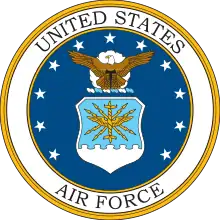
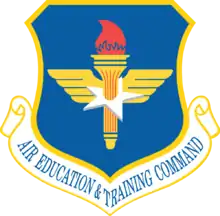
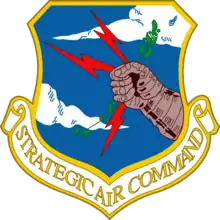
.svg.png.webp)
.svg.png.webp)